#Monotremes
Text
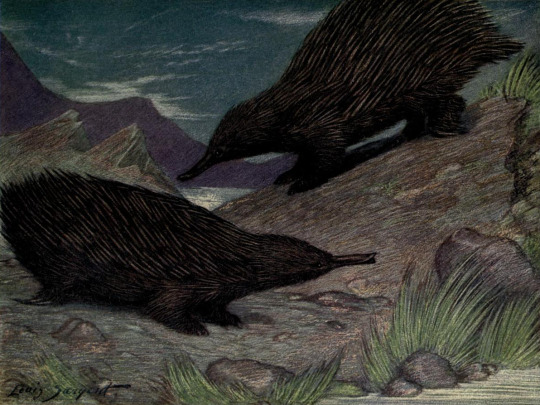
Echidnas by Louis A. Sargent. From Wild Beasts of the World, Vol. Two. Written by Frank Finn, published in 1909.
Internet Archive
398 notes
·
View notes
Text

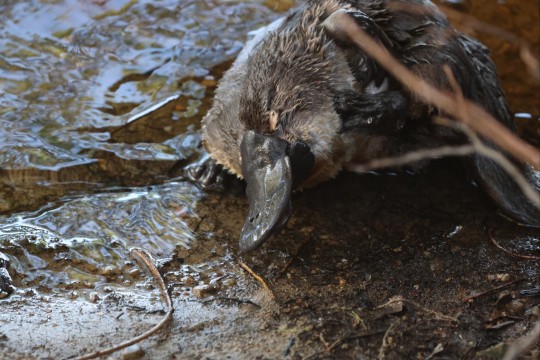



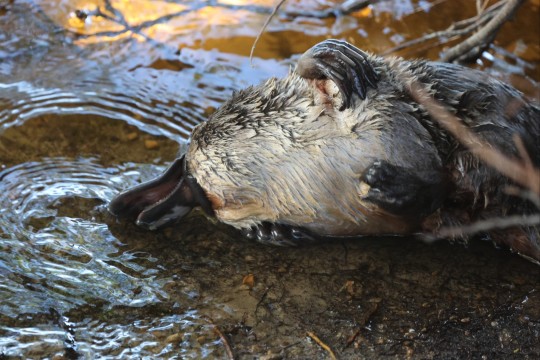
Wet beast experiences bliss (a very good scritch)
We watched this tiny platypus for a while, diving and feeding. Then it came out onto the bank, surprisingly bold, to have a scratch.
I'm obsessed with monotremes.
#monotremes#platypuses#platypi#wet beast wednesday#wet beast wednesday saturday#platypus#tasmania#tasmanian wildlife#australia#australian wildlife#wildlife#wet beast#sky darcy edwards#animals
491 notes
·
View notes
Text

Did you know? The short-beaked echidna (Tachyglossus aculeatus) is a monotreme, meaning it’s one of the few mammals that lays eggs instead of bearing live young. This species lives for an average of 10 years in the wild, and up to 50 years in captivity. Weighing up to 15.4 lbs (7 kg), this spiky critter can be found in parts of Australia, New Guinea, and Tasmania. It feeds on invertebrates like ants and termites.
Photo: crapgame, CC BY-NC 4.0, iNautralist
#science#nature#echidna#monotremes#animal facts#animal kingdom#cool animals#fun animal facts#fact of the day#dyk#mammal
461 notes
·
View notes
Text
Uncharismatic Fact of the Day
Blowing bubbles is a great summer pastime, especially for echidnas! Too keep themselves cool, short-beaked echidnas blow snot bubbles, and the mucus wets their snouts. When it the mucus evaporates the moisture draws out heat-- an efficient cooling method known as evaporative cooling.

(Image: A short-beaked echidna (Tachyglossus aculeatus) by Jamie Lamb)
373 notes
·
View notes
Text
Wonderful news from the Cyclops Mountains of West Papua today with the rediscovery of Attenborough's long-beaked echidna (Zaglossus attenboroughi)!

(Image credit: Expedition Cyclops)
Previously known a single specimen collected in 1961, Attenborough's long-beaked echidna has long been one of the world's most elusive mammals. Recognised as a distinct species in 1998, an expedition to the Cyclops Mountains in 2007 failed to observe the echidna but found evidence of recent diggings and foraging activity which, alongside local knowledge, implied that the species still survived in those remote mountain forests.
Finally, just a few months ago, a new expedition into its remote mountain home by Expedition Cyclops caught the first ever footage of Attenborough's long-beaked echidna in the wild, which is also the first time it has been seen by scientists in over 60 years. In a remarkable stroke of luck, the echidna was captured on the last of over 80 camera traps on the final day of the trip!
Attenborough's long-beaked echidna is the most distinctive of the three species of long-beaked echidna thanks to its smaller size, shorter, straighter beak and reddish-brown fur. Its habits are virtually unknown, but its differently shaped beak may suggest that it differs in diet and feeding habits from the other two long-beaked echidna species. It appears to be endemic to the highest elevations of the Cyclops Mountains, which are steep, extremely rainy and treacherous to explore, hence why it remained hidden for so long.

(Image credit: Expedition Cyclops)
There are only five species of monotreme alive today, the sole living custodians of a lineage stretching back some 200 million years, and this makes each species extraordinarily valuable. Unfortunately, all three species of long-beaked echidna are threatened with extinction, with Attenborough's long-beaked echidna being classed as critically endangered. Losing any species is a tragedy, but for a group as small and precious as monotremes, any extinction would be especially disastrous.
Alongside the rediscovery of the echidna, Expedition Cyclops also made the first record of Mayr's honeyeater (Ptiloprora mayri) in 16 years and discovered dozens of new species of insects, arachnids, shrimp and frogs. Their work documenting the hidden biodiversity of the Cyclops Mountains is ongoing, so if you'd like to follow and support the expedition make sure to visit their website!
https://www.expeditioncyclops.org/
#oceania#papua#west papua#new guinea#wildlife#mammal#mammals#monotreme#monotremes#echidna#echidnas#animal facts#animal news#mammalogy#natural history#my stuff
288 notes
·
View notes
Text
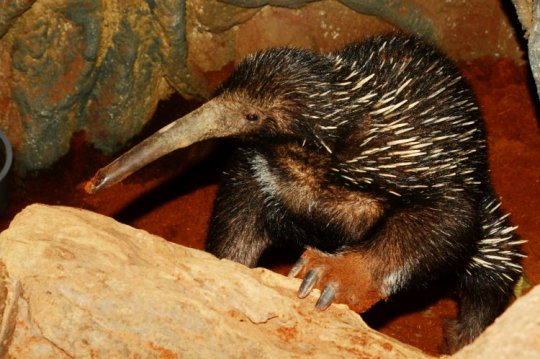
A Western long beaked echinda (Zaglossus bruijnii) in Batu Secret Zoo, Java, Indonesia
by Johannes Pfleiderer
#western long beaked echidna#long beaked echidnas#echidnas#monotremes#zaglossus bruijnii#zaglossus#tachyglossidae#monotremata#mammalia#chordata#captive animal#batu secret zoo
245 notes
·
View notes
Photo

The wild beasts of the world - 1909 - via Internet Archive
626 notes
·
View notes
Text

Short-beaked echidna! The four species of echidna and the platypus are the world’s only egg-laying mammals! Echidnas are monotremes, meaning they both lay eggs and nurse their young. Echidna babies are called puggles, and are nursed in a pouch until they start developing their spines at around 50 days old.
[ID: an illustration of an echidna facing toward the viewer, with termite mounds in the background. End.]
268 notes
·
View notes
Text




Fat Echidna found on Woppa (they do inhabit the island as well as the mainland).
Sadly, while driving to Yeppoon, we saw a lot of dead echidnas on the road... The highway is frequently covered in native animal roadkill. At least on Woppa, there's little chance of an echidna being runover.
BTW, despite looking like hedgehogs, they're very much unrelated. Echidnas are their own thing (closely related to the platypus).
11/09/23 - Mammalia: Tachyglossus aculeatus - Woppa, cabin area
#Tachyglossus aculeatus#Echidna#Monotremata#Monotremes#Mammalia#Mammals#Prototheria#Prototherians#Vertebrata#Vertebrates#Chordata#Chordates
115 notes
·
View notes
Text
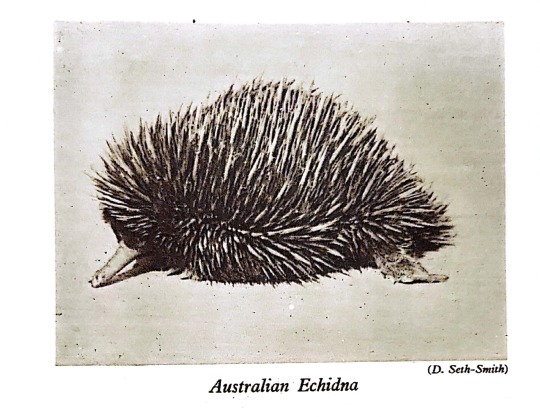
An Australian echidna.
Notes: Edward George Boulenger was the Director of Zoological Society of London's Aquarium as well as its curator of fish and later curator of reptiles. David Seth-Smith would intermittently serve as the Society's curator of mammals and birds, but was perhaps best known for his career as a nature broadcaster, and is colloquially and affectionately known as the 'Zoo Man' by young contemporaries.
Source: Photograph by F.W. Bond in E.G. Boulenger's Animal Ways (London: Ward, Lock & Co., Limited, 1931).
61 notes
·
View notes
Photo
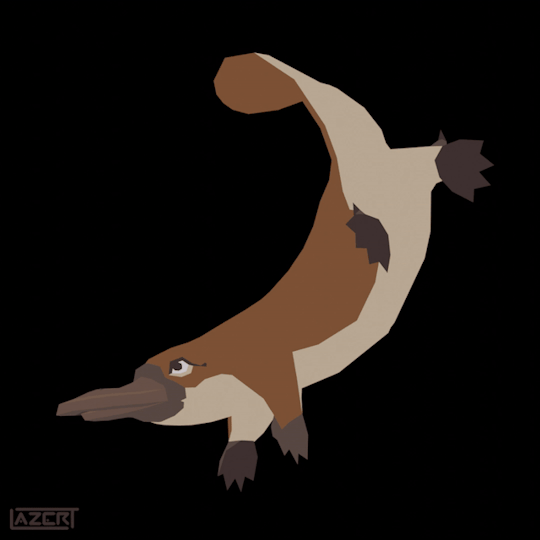
Platypus (render 1/2)
#art#my art#digital#digital art#3d#3d model#3d modeling#3d modelling#blender#blender3d#blender 3d#turnaround#animated#animated gif#gif#platypus#monotremes#animals#low poly#lowpoly#npr 3d#lazert#lazer-t
429 notes
·
View notes
Text
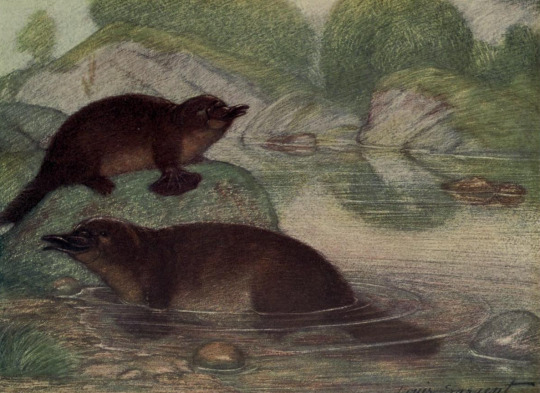
Duck-Billed Platypus by Louis A. Sargent. From Wild Beasts of the World, Vol. Two. Written by Frank Finn, published in 1909.
Internet Archive
345 notes
·
View notes
Text

A shy beast.
I didn't really understand echidnas until I looked at them properly, in person. They are so charming. And so silly. I'm obsessed with them now.
Taken in Dryandra Woodland, 9/4/23
Canon R7
Canon EF 100-400 L IS USM
#echidnas#wildlife#monotremes#mammals#australianwildlife#australia#wildlifephotography#beasts#echidna#dryandra#dryandra woodland
61 notes
·
View notes
Text
Something cute and fun for #MonotremeMonday featuring my favorite animal on the planet:

Chris Orr (English, b. 1943)
Platypus on Holiday, 1967
Watercolor on paper, 10 x 15 cm (3¾ x 5¾ in.)
#animals in art#european art#20th century art#watercolor#painting#Chris Orr#illustration#platypus#monotremes#Australian animals#1960s#Monotreme Monday#modern art
14 notes
·
View notes
Text
Uncharismatic Fact of the Day
Echidnas might appear spiky, but their signature look actually just a unique hairdo! Each spine is a thick, hollow hair follicle reinforced with keratin- the same protein that makes up claws, horns, and fur. In addition to this prickly defense mechanism, echidnas also have a layer of shorter fur that keeps them warm.

(Image: A short-beaked echidna (Tachyglossus aculeatus) by Tamara Montgomery)
If you like what I do, consider leaving a tip or buying me a ko-fi!
307 notes
·
View notes
Photo
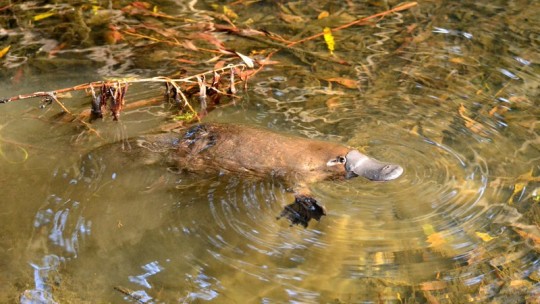
A platypus (Ornithorhynchus anatinus) swims in a creek in Tasmania
by Klaus
#platypus#duck billed platypus#monotremes#ornithorhynchus anatinus#ornithorhynchus#Ornithorhynchidae#monotremata#mammalia#chordata#wildlife: tasmania
888 notes
·
View notes